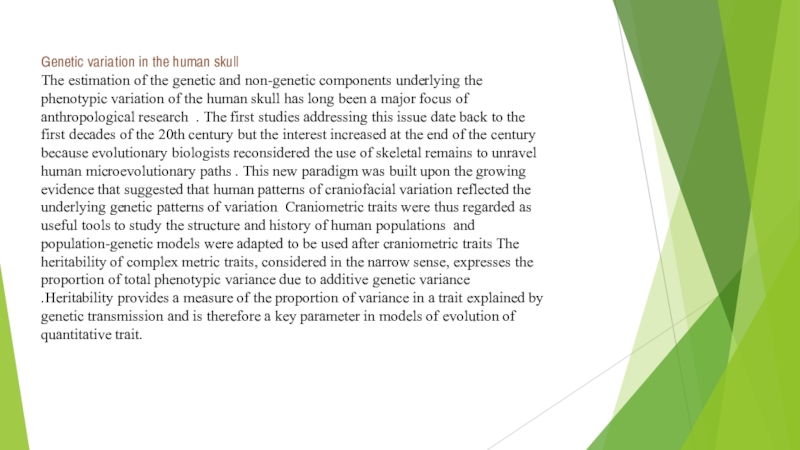Слайд 1PHYLOGENETIC DISORDERS of SKULL
Ganachari Jayshri Rajaram
1st –Course
195B
Слайд 2Discussion
This Study the levels of Genetics Variation and Correlation
of Craniometric traits through a developmentlal/Funtional approach to asses the
evolutionary potential of the Human skull
The comparison of the different studies is controversial as they been computed in many different kinds of samples
Слайд 5The chart is flowing from left to right with the
current human skull on the far right and the earliest
found hominid skull on the left. The first picture (far left) in the series is the skull of an Australopithecus, which is a human species that archaeologists have uncovered and deemed to have been around 2-4 million years ago. The next photo is that of a homo erectus, a human species whose fossils started to appear about two million years ago. The skull of the Homo erectus not only allowed for a bigger brain (in sheer size) than that of the Australopithecus, but it also allowed for a bigger brain as proportionate to the rest of the body. To the right of the photo of the skull of the Homo erectus is a skull of the Neanderthal, or Homo sapien Neanderthal, which came into being around 250,000 years ago and is the closest extinct relative of the human, as we know it. Some of the features of the skull of the Neanderthal are the large middle part of the face, angled cheekbones, and a large nose.
Слайд 7FOSSILS
Examining the skulls of living apes and our extinct
ancestors allows us to explore characteristics which reflect the evolutionary
relationships in our family tree. These skulls are all casts of original fossils.
The ancestors of today's modern apes (gorillas, orangutans, gibbons, chimpanzees and humans) first appeared in the fossil record about 27 million years ago. By examining their skulls we can explore characteristics which reflect their evolutionary relationships.
Слайд 8Human skull has substantial amount of genetic variation and t-test
showed that there are no statistically significant difference among the
heritabilities of facial , neurocranial and basal dimensions.However,skull evolvabilty is limited by complex patterns of genetic correlation.Phenotypic and genetic patterns of correlation are consistent but do not support traditional hypothesis of intergrationbof human shape, showing that the classification between brachy and dolicephalic skulls is not grounded on Genetic level
Слайд 9Genetic variation in the human skull
The estimation of the genetic
and non-genetic components underlying the phenotypic variation of the human
skull has long been a major focus of anthropological research . The first studies addressing this issue date back to the first decades of the 20th century but the interest increased at the end of the century because evolutionary biologists reconsidered the use of skeletal remains to unravel human microevolutionary paths . This new paradigm was built upon the growing evidence that suggested that human patterns of craniofacial variation reflected the underlying genetic patterns of variation Craniometric traits were thus regarded as useful tools to study the structure and history of human populations and population-genetic models were adapted to be used after craniometric traits The heritability of complex metric traits, considered in the narrow sense, expresses the proportion of total phenotypic variance due to additive genetic variance .Heritability provides a measure of the proportion of variance in a trait explained by genetic transmission and is therefore a key parameter in models of evolution of quantitative trait.

Слайд 11The rapid progress witnessed in computerized medical image analysis and
computer-aided diagnosis has promoted many imaging techniques to find applications
in medical image processing. Among the various imaging techniques, MRI (magnetic resonance image) is the most widely used imaging technique in the medical field. It is a noninvasive, nondestructive, flexible imaging tool that does not require ionizing radiation such as X-rays.
Слайд 12Skull Stripping of MR Brain Images
The MRI system produces brain
image as 3D volumetric data expressed as a stack of
two-dimensional slices and it is necessary to use computer-aided tool to explore the information contained in these brain slices for various brain image applications such as volumetric analysis, study of anatomical structure, localization of pathology, diagnosis, treatment planning, surgical planning, computer-integrated surgery, construction of anatomical models, 3D visualization, and research.
Several image processing methods are required before the brain images can be explored.
Слайд 14Intensity-Based Methods
Intensity-based methods use the intensity values of the image
pixel to separate the brain and non-brain region. For example,
histogram-based method, edge-based method, and region growing methods are intensity-based methods. These methods rely upon modeling the intensity distribution function to classify the brain and non-brain tissues in the brain images. The main limitation of these methods is they are sensitive to intensity bias due to various imperfection introduced in MRI head scan images such as low resolution, high level of noise, low contrast, and the presence of various imaging artifacts.
Слайд 19Craniosynostosis is a birth defect of the brain characterized by the
premature closure of one or more of the fibrous joints
between the bones of the skull (called cranial sutures) before brain growth is complete